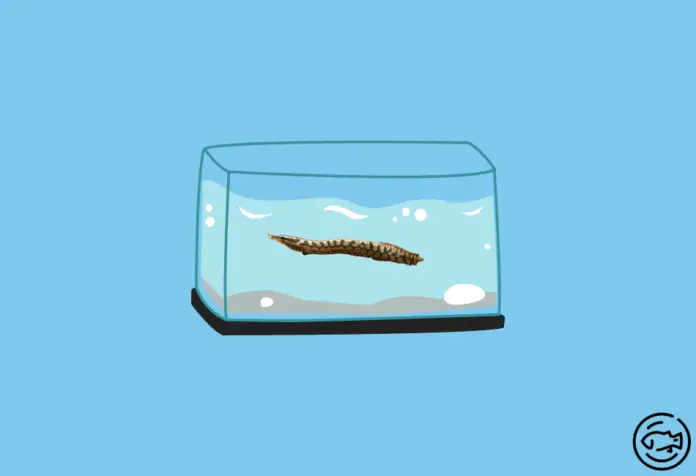Are you searching for guidance on how to look after your Tire-Track Eel?
And are you curious about the proper way to feed them? You’ve come to the right spot!
This article delves into every aspect of their care and nurturing, ensuring they flourish. It also offers valuable advice on compatible tank companions and other subjects that contribute to the happiness and well-being of your tire-track eels.
First, let’s identify Tire-Track Eels (Mastacembelus armatus).
Their bodies display the typical eel form, laterally compressed and featuring a snout-like visage. Their dark, zigzag patterns from head to tail also make them resemble snakes. Continue reading to discover more about this enchanting aquatic creature in depth.
Species Overview
Widespread throughout Asia, the Tire Track Eel is a tropical freshwater eel species belonging to the Mastacembelidae family.
These eels inhabit diverse environments, from highland streams with sand, pebble, or boulder substrates to lowland wetlands and flooded forests.
If you’re contemplating adding one to your home aquarium, remember that this fish grows quite large, making it unsuitable for small tanks and less popular among average aquarists.
However, it’s highly sought-after among those who keep large fish due to its peaceful nature towards other species in community aquariums.
Tire-Track Eels are known for their tolerance of tank companions. In general, the Tire-Track Eel is a peaceful yet challenging fish to keep in an aquarium, making it a great choice for experienced aquarists seeking something different.
These fish prefer low-light aquariums with numerous hiding spots but will actively swim around when well-adjusted and properly cared for.
Tire Track Eel Care

Tire track eels are relatively easy to manage but need specific attention, and these eels are among the most common fish kept in community aquariums.
As adaptable creatures, they can coexist with other fish species and live harmoniously with them. Caring for tire-track eels is simple, but they do require particular attention.
Providing a balanced diet, ample hiding places, and sufficient swimming space will keep them healthy and flourishing. However, Tire-Track Eels can be susceptible to rash environmental changes.
For example, moving them from their home to a new tank could cause stress. To avoid this, ensure that food and tank conditions remain stable.
Tank Size
Tire-Track Eels are relatively active fish, spending much of their time in caves before hunting and exploring at night. Due to their size, they require a spacious aquarium. A 48″ x 24″ aquarium or around 132 gallons is a suitable starting size. However, providing your Tire-Track Eel with ample open water and narrow channels – ideal for hunting and scavenging – will give you the best chance of having a healthy, content fish.
Diet
Being omnivorous and nocturnal, Tire Track eels feed on various sources such as benthic invertebrates, fish, plant matter, and debris. In their natural surroundings, their main diet includes live fish, benthic insect larvae, worms, other aquatic invertebrates, and some plant material.
Feeding a Tyre Track eel in an aquarium setting can be challenging, as they generally struggle to accept commercial food options. They have a preference for fresh, live nourishment like live fish, brine shrimp, bloodworms, and earthworms.
It’s essential to strike a balance when feeding these eels, as overfeeding may result in poor digestion and health issues while underfeeding could lead to malnourishment and potentially death. Offering food several times a week serves as a useful guideline.
Ensuring a diverse and well-balanced diet is key to showcasing the eel’s full potential. These fish often seem to be perpetually hungry.
Water Parameters
These fish are adaptable, demonstrating exceptional resilience across various conditions. However, they do struggle when faced with abrupt alterations in their environment.
The species exhibits particular sensitivity to water impurities and organic waste accumulation within their aquatic habitat.
The fish’s origin region directly influences the disparity between hardness and pH levels, reflecting the cyclical shift in conditions between wet and dry seasons. Interestingly, these fish show a preference for slightly saline water (indicating high hardness), often thriving in such situations.
Maintaining optimal conditions for their well-being includes managing the temperature within a band of 75 to 82°F. It’s also crucial to keep the pH level within the 6.0 to 7.0 range and ensure water hardness between 5 to 12°H.
Tank Mates
These semi-aggressive eels coexist peacefully with other fish species in community aquariums. However, it’s best to house Tire Track Eels with larger fish they can’t eat and avoid keeping them with other territorial and aggressive fish.
Suitable tank mates for Tire Track Eels include Geophagus, Acara, Knifefish, Loaches, Gouramis. Tire Track eels should be maintained with comparable species that won’t harm the eel or be seen as food by this creature.
Same Species Tanks
The Tire Track Eel is infrequently used as a single species in any assembly; keeping the animal in a group is safe.
also read: Pea Puffer – Tank Mates, Size, Care, Lifespan, Sale & More!
Lifespan
In an aquarium with stable parameters and an ideal diet, Tire Track Eels can live up to 18 years, with the most common lifespan being around ten years. Their lifespans are typically shorter in the wild due to disease, predation, and environmental factors.
Appearance
Adult Tire-Track Eels have an elongated body and a long snout, with extended dorsal and anal fins connected to the caudal fin.
Their body is light-colored with a slightly brownish hue, and a darker zigzag-shaped marking runs along the body, crossing the eel’s eye laterally. This marking is what gives them the name “Zig-Zag Eel.”
Size
Tire Track Eels can easily reach 35 inches in length when well-cared for and fed. However, the most common size in domestic aquariums is around 20 inches.
Behavior and Temperament
These fish are surprisingly peaceful and prefer to keep to themselves. While they generally avoid conflict, they may mistake smaller fish for food, so it’s best to hold them in a community tank with larger fish or fish of a similar size.
As mentioned earlier, Tire-Track eels can live in peace with other fish species in the tank if they share a similar temperament.
They could be more active swimmers during the day but can be found in open swimming spaces at night.
Breeding
There are extremely few reports of successful breeding in domestic aquariums. One reason is the difficulty of keeping more than one fish in the same aquarium and accurately sexing them. However, essential conditioning for tropical fish may work with Tire-Track eels.
They are oviparous, and no parental care occurs. The courtship process takes several hours, involving chasing each other and swimming in circles.
The female then lays eggs among the roots of floating plants, and the adhesive eggs attach to the plants and hatch in 3 to 4 days. The fry becomes free-swimming a few days later and readily accepts nauplii as food.
However, raising the larvae is challenging and complex, as the fry is susceptible to fungal infections.
Gender Differences: Male vs. Female
There is no obvious sexual dimorphism. However, experienced hobbyists suggest that adult males tend to be wider and more robust when viewed from above.
What Should You Include in Their Aquarium?
As with any other species raised in captivity, Tire Track Eels necessitate both a reliable heating system and filtration setup in their tank to promote their well-being.
The filtration system should be sufficiently robust, and considering these creatures’ impressive leaping abilities, a securely fitted cover for the tank is a must.
The setup and aesthetics of the tank play a significant role in sustaining this species, and the eels require plenty of refuges and large areas. A densely vegetated aquarium would be an excellent dwelling for your Tire Track Eel.
We suggest incorporating a large number of stones and driftwood to construct hideaways and caves. A sandy substrate is also advisable, given these beings’ propensity to submerge themselves.
Common Diseases
Despite their notable resilience to diseases, these eels have minimal scale coverage, making them susceptible to fungal infections and parasites. This sensitivity extends to medications, especially those containing copper, so avoiding such treatments is crucial.
Maintaining prime conditions in the aquarium and water is a proactive measure that helps prevent health issues.
Also, before introducing new fish to the primary habitat, a period of isolation and observation is always a wise practice.
This ensures that your existing ecosystem stays healthy and balanced.
Fun Facts – Tire-Track Eel
- Not classified as a true eel despite its appearance
- Part of the Mastacembelidae family, known as spiny eels due to body shape
- Described by Lacepède in the 1800s, popular in the modern aquarium hobby
- Many common names, including Tyre Track Eel, White-Spotted Spiny Eel, and Leopard Spiny Eel
- Tire-Track Eel label may incorrectly apply to other spiny eel species (M. armatus, M. favus, Macrognathus circumcinctus)
- Similarities in juvenile appearance and coloring can cause confusion between M. armatus and M. favus
- Reticulated marking pattern on the body is a distinctive feature
- Tire-Track Eel (Mastacembelus armatus) is widely available in stores globally
- ‘Thorny eels’ nickname due to the spines on their back, harmless to humans
- It makes an enjoyable addition to home aquariums with proper care, space, and food requirements met



